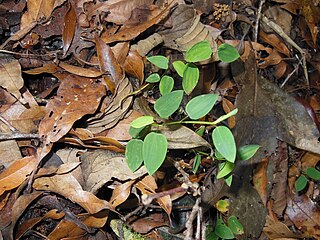
Saccharum is a genus of tall perennial plants of the broomsedge tribe within the grass family.

The Cyperaceae are a family of graminoid (grass-like), monocotyledonous flowering plants known as sedges. The family is large; botanists have described some 5,500 known species in about 90 genera – the largest being the "true sedges", with over 2,000 species.

Pennisetum is a widespread genus of plants in the grass family, native to tropical and warm temperate regions of the world. They are known commonly as fountaingrasses. Pennisetum is considered a synonym of Cenchrus in Kew's Plants of the World Online.

Cenchrus is a widespread genus of plants in the grass family. Its species are native to many countries in Asia, Africa, Australia, the Americas, and various oceanic islands.

Pharus, the stalkgrasses, is a genus of Neotropical plants in the grass family.

Setaria is a widespread genus of plants in the grass family. The name is derived from the Latin word seta, meaning "bristle" or "hair", which refers to the bristly spikelets.

Zeugites is a genus of flowering plants in the family Poaceae. Its species are native to the Caribbean, Mexico, Central America, and South America.

Zizaniopsis is a genus of plants in the grass family, Poaceae, native to North and South America.

Potamophila is a genus of Australian plants in the grass family.

Raddia is a genus of South American plants in the grass family, most of the species found only in Brazil.
Agenium is a genus of South American plants in the grass family.

Arthropogon is a genus of South American and Caribbean bunchgrass plants in the grass family.
Chaetium is a genus of Neotropical plants in the grass family.

Loudetia is a genus of African, Arabian, and South American plants in the grass family.
Louisiella is a genus of African, Neotropical and tropical plants in the grass family. Earlier the genus was known to comprise only two species i.e. L. fluitans and L. elephantipes.Mr. Shahid Nawaz, an agrostologist at the Blatter Herbarium (BLAT), transferred a species Panicum paludosum Roxb. into Louisiella based on critical study of the morphological features. Now, there are three globally accepted species in the genus.
Cryptochloa is a genus of Neotropical plants in the grass family, widespread across much of Mexico, Central America, and South America.
- Cryptochloa capillata(Trin.) Soderstr. - French Guiana, Brazil
- Cryptochloa concinna(Hook.f.) Swallen - Colombia, Central America, southern Mexico
- Cryptochloa decumbensSoderstr. & Zuloaga - Panama
- Cryptochloa dressleriSoderstr. - Panama
- Cryptochloa soderstromiiDavidse - Panama
- Cryptochloa strictiflora(E.Fourn.) Swallen - Central America, southern Mexico, Ecuador
- Cryptochloa unispiculataSoderstr. - Bolivia, Peru, Ecuador, Colombia, Brazil (Acre)
- Cryptochloa varianaSwallen - Honduras, Panama, Colombia
Steyermarkochloa is a genus of plants in the grass family. The only known species is Steyermarkochloa angustifolia(Spreng.) Judz., which is native to Colombia (Guainía), Venezuela (Amazonas), and Brazil (Amazonas).

Tristachya is a genus of African and Latin American plants in tribe Tristachyideae within the grass family.

Hymenachne, synonym Dallwatsonia, is a genus of widespread wetland plants in the grass family Poaceae. They are commonly known as marsh grasses. They are distributed in tropical and subtropical regions of Asia, the Americas, and the Pacific Islands. A species from the Americas, H. amplexicaulis, is well known in other parts of the world as an introduced and invasive species.

Euclasta is a genus of Asian, African, and Neotropical plants in the grass family.















